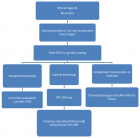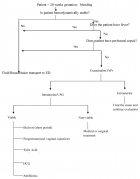Abstract
Review Article
Overview on current approach on recurrent miscarriage and threatened miscarriage
Basant Sharma*, Jagat Deep, Chandrika Pandit, Bina Basnyat, Bandana Khanal, BB Raut, Brij Mohan Rajak, Deepak Patel, Rangina Laikangbam and Rajendra Basyal
Published: 30 November, 2020 | Volume 3 - Issue 2 | Pages: 151-157
Miscarriage is a frequent outcome of pregnancy, with major emotional implications to the couple experiencing such an event. Threatened miscarriage is the commonest complication of early pregnancy and affects about 20% of pregnancies. It presents with vaginal bleeding with or without abdominal cramps. On the other hand recurrent miscarriages are post implantation failures in natural conception. Increasing age of women, smoking, obesity or polycystic ovary syndrome (PCOS) and a previous history of miscarriage are risk factors for threatened miscarriage. The pathophysiology has been associated with changes in levels of cytokines or maternal immune dysfunction. Clinical history and examination, maternal serum biochemistry and ultrasound findings are important to determine the treatment options and provide valuable information for the prognosis. Many surgical and non-surgical interventions are used in the management of threatened and recurrent miscarriages. In this review, we present available evidence-based guidance on the incidence, pathophysiology, investigation and clinical management of recurrent miscarriage and threatened miscarriage, focusing mainly on the first trimester of pregnancy and primary healthcare settings. The review is structured to be clinically relevant. We have critically appraised the evidence to produce a concise answer for clinical practice.
Read Full Article HTML DOI: 10.29328/journal.cjog.1001070 Cite this Article Read Full Article PDF
Keywords:
Miscarriage; Pregnancy; Recurrent; Threatened
References
- RCOG Green Top Guideline. The investigation and treatment of couples with recurrent first-trimester and second-trimester miscarriage, RCOG Green Top Guideline. 2011; 17: 1-17.
- Radford EJ, Hughes M. Women's experiences of early miscarriage: implications for nursing care. J Clin Nurs. 2015; 24: 1457-1465. PubMed: https://pubmed.ncbi.nlm.nih.gov/25662397/
- Horne AW, Alexander CI. Recurrent miscarriage. J Fam Plann Reprod Health Care. 2005; 31: 103-107. PubMed: https://pubmed.ncbi.nlm.nih.gov/15921544/
- El Hachem H, Crepaux V, May-Panloup P, Descamps P, Legendre G, Bouet PE. Recurrent pregnancy loss: current perspectives. Int J Womens Health. 2017; 9: 331-345. PubMed: https://pubmed.ncbi.nlm.nih.gov/28553146/
- Homer HA. Modern management of recurrent miscarriage. Aust N Z J Obstet Gynaecol. 2019; 59: 36-44. PubMed: https://pubmed.ncbi.nlm.nih.gov/30393965/
- Patki A, Chauhan N. An epidemiology study to determine the prevalence and risk factors associated with recurrent spontaneous miscarriage in India. J Obstet Gynaecol India. 2016; 66: 310-315. PubMed: https://pubmed.ncbi.nlm.nih.gov/27486274/
- Garrido-Gimenez C, Alijotas-Reig J. Recurrent miscarriage: causes, evaluation and management. Postgrad Med J. 2015; 91: 151-162. PubMed: https://pubmed.ncbi.nlm.nih.gov/25681385/
- Lia J, Gaob JS, Wangc CC, Ngd EH, Wub XK. Evidence-based interventions of threatened miscarriage. World. 2017; 3: 50-59.
- Jaslow C, Carney J, Kutteh W. Diagnostic factors identified in 1020 women with two versus three or more recurrent pregnancy losses. Fertil Steril 2010; 93: 1234–1243. PubMed: https://pubmed.ncbi.nlm.nih.gov/19338986/
- French DA. A clinician’s approach to the diagnosis and management of recurrent pregnancy loss. Physician Assistant Clinics. 2018; 3: 457-468.
- Jefferys A, Vanderpump M, Yasmin E. Thyroid dysfunction and reproductive health. Obs Gynaecol. 2015; 17: 39–45.
- Brezina P, Kutteh W. Classic and cutting-edge strategies for the management of early pregnancy loss. Obstet Gynecol Clin North Am. 2014; 41: 1–18. PubMed: https://pubmed.ncbi.nlm.nih.gov/24491981/
- Tien JC, Tan TY. Non-surgical interventions for threatened and recurrent miscarriages. Singapore Med J. 2007; 48: 1074-1090. PubMed: https://pubmed.ncbi.nlm.nih.gov/18043834/
- Li YH, Marren A. Recurrent pregnancy loss. Aust J Gen Pract. 2018; 47: 432. PubMed: https://pubmed.ncbi.nlm.nih.gov/30114870/
- Kutteh WH. Novel strategies for the management of recurrent pregnancy loss. Semin Reprod Med. 2015; 33: 161-168. PubMed: https://pubmed.ncbi.nlm.nih.gov/26036897/
- Ford HB, Schust DJ. Recurrent pregnancy loss: etiology, diagnosis, and therapy. Reviews in obstetrics and gynecology. 2009; 2: 76-83. PubMed: https://pubmed.ncbi.nlm.nih.gov/19609401/
- Griebel CP, Halvorsen J, Golemon TB, Day AA. Management of spontaneous abortion. Am Fam Physician. 2005; 72: 1243-1250. PubMed: https://pubmed.ncbi.nlm.nih.gov/16225027/
- Sotiriadis A, Papatheodorou S, Makrydimas G. Threatened miscarriage: evaluation and management. BMJ. 2004; 329: 152-155. PubMed: https://pubmed.ncbi.nlm.nih.gov/15258071/
- Harrison RF. A comparative study of human chorionic gonadotropin, placebo, and bed rest for women with early threatened abortion. Int J Fertil Menopausal Stud. 1993; 38: 160-165. PubMed: https://pubmed.ncbi.nlm.nih.gov/8348164/
- Arck PC, Rücke M, Rose M, Szekeres-Bartho J, Douglas AJ, Pritsch M, et al. Early risk factors for miscarriage: a prospective cohort study in pregnant women. Reprod Biomed Online. 2008; 17: 101-113. PubMed: https://pubmed.ncbi.nlm.nih.gov/18616898/
- Brenner B, Bar J, Ellis M, Yarom I, Yohai D, Samueloff A et al. Effects of enoxaparin on late pregnancy complications and neonatal outcome in women with recurrent pregnancy loss and thrombophilia: results from the Live-Enox study. Fertil Steril. 2005; 84: 770-773. PubMed: https://pubmed.ncbi.nlm.nih.gov/16169422/
- Hendriks E, MacNaughton H, MacKenzie MC. First Trimester Bleeding: Evaluation and Management. Am Fam Physician. 2019; 99: 166-174. PubMed: https://pubmed.ncbi.nlm.nih.gov/30702252/
- Devaseelan P, Fogarty PP, Regan L. Human chorionic gonadotrophin for threatened miscarriage. Cochrane Database Syst Rev. 2010; 5: CD007422. PubMed: https://pubmed.ncbi.nlm.nih.gov/20464754/
- Coppola PT, Coppola M. Vaginal bleeding in the first 20 weeks of pregnancy. Emerg Med Clin North Am. 2003; 21: 667-677. PubMed: https://pubmed.ncbi.nlm.nih.gov/12962352/
- Nybo Andersen AM, Wohlfahrt J, Christens P, Olsen J, Melbye M. Maternal age and fetal loss: population based register linkage study. BMJ. 2000; 320: 1708-1712. PubMed: https://pubmed.ncbi.nlm.nih.gov/10864550/
- Brezina PR, Kutteh WH. Recurrent early pregnancy loss. In Clinical Reproductive Medicine and Surgery. 2013; 197-208.
- Mezzesimi A, Florio P, Reis FM, D'Aniello G, Sabatini L, et al. The detection of anti-beta2-glycoprotein I antibodies is associated with increased risk of pregnancy loss in women with threatened abortion in the first trimester. Eur J Obstet Gynecol Reprod Biol. 2007; 133: 164-168. PubMed: https://pubmed.ncbi.nlm.nih.gov/17046145/
- van der Spuy ZM, Dyer SJ. The pathogenesis of infertility and early pregnancy loss in polycystic ovary syndrome. Best Pract Res Clin Obstet Gynaecol. 2004; 18: 755–771. PubMed: https://pubmed.ncbi.nlm.nih.gov/15380145/
- Mouri M, Rupp TJ. Threatened Abortion. InStatPearls [Internet] 2019 May 6. StatPearls Publishing.
- Qureshi NS. Treatment options for threatened miscarriage. Maturitas. 2009; 65 Suppl 1: S35-41. PubMed: https://pubmed.ncbi.nlm.nih.gov/19945236/
- Oates-Whitehead RM, Haas DM, Carrier JAK. Progestogen for preventing miscarriage. In: Cochrane Library. Chichester: Wiley, 2003. CD003511. PubMed: https://pubmed.ncbi.nlm.nih.gov/14583982/
Figures:

Figure 1

Figure 2

Figure 3

Figure 4
Similar Articles
-
TMD and pregnancy?Afa Bayramova*. TMD and pregnancy?. . 2018 doi: 10.29328/journal.cjog.1001001; 1: 001-006
-
Screening of Gestational diabetes mellitusGehan Farid*,Sarah Rabie Ali*,Reem Mohammed Kamal. Screening of Gestational diabetes mellitus . . 2018 doi: 10.29328/journal.cjog.1001003; 1: 014-023
-
The Case of the Phantom Trophoblastic TumorBenedict B Benigno*. The Case of the Phantom Trophoblastic Tumor. . 2018 doi: 10.29328/journal.cjog.1001004; 1: 024-025
-
Maternal and fetal outcome of comparative study between old & adopted new value of screening of Gestational Diabetes Mellitus in tertiary centre in Saudi ArabiaGehan Farid*,Reem Mohammed Kamal*,Mohamed AH Swaraldahab,Sarah Rabie Ali. Maternal and fetal outcome of comparative study between old & adopted new value of screening of Gestational Diabetes Mellitus in tertiary centre in Saudi Arabia. . 2018 doi: 10.29328/journal.cjog.1001005; 1: 026-034
-
Septic arthritis of left shoulder in pregnancy following minor hand injuryNeelam Agrawal,Rhoughton Clemmey,Shamma Al-Inizi*. Septic arthritis of left shoulder in pregnancy following minor hand injury. . 2018 doi: 10.29328/journal.cjog.1001010; 1: 058-060
-
Value of ambulatory blood pressure measure in pregnancy hypertensionAna Correia*,Fátima Leitão. Value of ambulatory blood pressure measure in pregnancy hypertension. . 2018 doi: 10.29328/journal.cjog.1001012; 1: 067-072
-
Managing epileptic women in pregnancySarmad Muhammad Soomar*,Saima Rajpali. Managing epileptic women in pregnancy. . 2019 doi: 10.29328/journal.cjog.1001015; 2: 001-002
-
Hypertriglyceridemia induced acute pancreatitis in pregnancy: Learning experiences and challenges of a Case reportSufia Athar*,Joohi Ramawat,Mohammad Abdel Aziz,Vincent Boama. Hypertriglyceridemia induced acute pancreatitis in pregnancy: Learning experiences and challenges of a Case report. . 2019 doi: 10.29328/journal.cjog.1001017; 2: 006-012
-
Trans-abdominal cervical cerclage revisitedJohn Svigos*. Trans-abdominal cervical cerclage revisited. . 2019 doi: 10.29328/journal.cjog.1001019; 2: 017-024
-
Determinants of women’s perceived satisfaction on Antenatal care in urban Ghana: A cross-sectional studyAkowuah Jones Asafo*,Danquah Benedicta Adoma. Determinants of women’s perceived satisfaction on Antenatal care in urban Ghana: A cross-sectional study. . 2019 doi: 10.29328/journal.cjog.1001022; 2: 038-053
Recently Viewed
-
Optimizing Treatment of Depression, Trauma, and Anxiety Disorders through Neurophysiological InterventionsKees Blasé*. Optimizing Treatment of Depression, Trauma, and Anxiety Disorders through Neurophysiological Interventions. Insights Depress Anxiety. 2025: doi: 10.29328/journal.ida.1001046; 9: 027-029
-
A Study on Incidence, Risk Factors, and Maternal Outcome of Placenta Accreta Spectrum in a Tertiary Care HospitalMittapalli Jyothirmayee**. A Study on Incidence, Risk Factors, and Maternal Outcome of Placenta Accreta Spectrum in a Tertiary Care Hospital. Clin J Obstet Gynecol. 2025: doi: 10.29328/journal.cjog.1001191; 8: 074-00
-
Breast Imaging Services Utilization Trends Across Private and Government-Insured Patients in a National Radiology PracticeAndrew K Hillman*,Phil Ramis,Patrick Nielsen,Sophia N Swanston,Dana Bonaminio,Eric M Rohren. Breast Imaging Services Utilization Trends Across Private and Government-Insured Patients in a National Radiology Practice. J Clin Med Exp Images. 2025: doi: 10.29328/journal.jcmei.1001037; 9: 020-027
-
A Rare Consanguineous Case of Alazami Syndrome in a Jordanian Family: Clinical Presentation, Genetic Analysis, and Therapeutic Approaches - A Case ReportFawzi Irshaid*, Salim Alawneh, Qasim Al Souhail, Aisha Alshdefat, Bashar Irshaid, Ahmed Irshaid. A Rare Consanguineous Case of Alazami Syndrome in a Jordanian Family: Clinical Presentation, Genetic Analysis, and Therapeutic Approaches - A Case Report. J Clin Med Exp Images. 2024: doi: 10.29328/journal.jcmei.1001031; 8: 003-006
-
Fiesta vs. Stress Condition the Incidence and the Age at Menarche. Forty Years of ResearchCarlos Y Valenzuela*. Fiesta vs. Stress Condition the Incidence and the Age at Menarche. Forty Years of Research. Clin J Obstet Gynecol. 2025: doi: 10.29328/journal.cjog.1001190; 8: 069-073
Most Viewed
-
Feasibility study of magnetic sensing for detecting single-neuron action potentialsDenis Tonini,Kai Wu,Renata Saha,Jian-Ping Wang*. Feasibility study of magnetic sensing for detecting single-neuron action potentials. Ann Biomed Sci Eng. 2022 doi: 10.29328/journal.abse.1001018; 6: 019-029
-
Evaluation of In vitro and Ex vivo Models for Studying the Effectiveness of Vaginal Drug Systems in Controlling Microbe Infections: A Systematic ReviewMohammad Hossein Karami*, Majid Abdouss*, Mandana Karami. Evaluation of In vitro and Ex vivo Models for Studying the Effectiveness of Vaginal Drug Systems in Controlling Microbe Infections: A Systematic Review. Clin J Obstet Gynecol. 2023 doi: 10.29328/journal.cjog.1001151; 6: 201-215
-
Causal Link between Human Blood Metabolites and Asthma: An Investigation Using Mendelian RandomizationYong-Qing Zhu, Xiao-Yan Meng, Jing-Hua Yang*. Causal Link between Human Blood Metabolites and Asthma: An Investigation Using Mendelian Randomization. Arch Asthma Allergy Immunol. 2023 doi: 10.29328/journal.aaai.1001032; 7: 012-022
-
Impact of Latex Sensitization on Asthma and Rhinitis Progression: A Study at Abidjan-Cocody University Hospital - Côte d’Ivoire (Progression of Asthma and Rhinitis related to Latex Sensitization)Dasse Sery Romuald*, KL Siransy, N Koffi, RO Yeboah, EK Nguessan, HA Adou, VP Goran-Kouacou, AU Assi, JY Seri, S Moussa, D Oura, CL Memel, H Koya, E Atoukoula. Impact of Latex Sensitization on Asthma and Rhinitis Progression: A Study at Abidjan-Cocody University Hospital - Côte d’Ivoire (Progression of Asthma and Rhinitis related to Latex Sensitization). Arch Asthma Allergy Immunol. 2024 doi: 10.29328/journal.aaai.1001035; 8: 007-012
-
An algorithm to safely manage oral food challenge in an office-based setting for children with multiple food allergiesNathalie Cottel,Aïcha Dieme,Véronique Orcel,Yannick Chantran,Mélisande Bourgoin-Heck,Jocelyne Just. An algorithm to safely manage oral food challenge in an office-based setting for children with multiple food allergies. Arch Asthma Allergy Immunol. 2021 doi: 10.29328/journal.aaai.1001027; 5: 030-037

If you are already a member of our network and need to keep track of any developments regarding a question you have already submitted, click "take me to my Query."


















































































































































